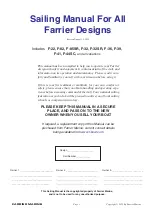
Safety
by Hobie Cat USA
Hobie University, NAHCA
Page 45
30 Mar 02
Although sailing is generally one of the safest
outdoor sports, carelessness can result in injury,
or, in some cases, death. It only takes a few
common sense precautionary measures to ensure
safe boating. Read through the recommended
steps before you venture out on your own.
Watch For Overhead Wires!
Contact of the mast with a powerline could result
in injury or death. Beware of powerlines
whenever sailing, rigging, launching or beaching
your boat, Despite oft repeated warnings issued
by Hobie Cat and other boat manufacturers, over
ten fatalities are recorded every year in the
United States as a result of mast/powerline
contact. Heed the warnings and remember to
watch for wires!
Never wheel your boat or trailer your boat with
the mast up. Do not raise the mast of your boat in
your yard, for example, unless you are positive
there are no electrical wires present. Never rig
your boat in a parking lot and raise the mast
before trailering down to a launch ramp unless
the facility is specially built for parking lot
rigging such as at a marina.
Lifevests
According to Coast Guard regulations, every
boater must sail with enough lifevests on board
for every person in the boat. This is probably the
single most basic safety precaution. The lifevests
should be Coast Guard approved and should be
worn at all times. These vests are designed to
keep an unconscious person afloat so that his
head remains out of the water:
Do Not Sail Offshore
Weather conditions can change very rapidly and
when they do, the least desirable place to be is
away from land, Although there are some
offshore races for Hobie Cats, these are tightly
controlled events with extraordinary safety
precautions, Also beware of electrical storms. If
the weather looks like it may change for the
worse, go directly to shore even if you are far
from where you launched. Lightning can kill.
Equipment
Just like any other pursuit, sailing requires the
proper equipment. Always be sure to check seals,
connections, shock cords, lines, sails, in short,
every part of your boat, to guarantee you will not
be caught unaware. To be sure, carefully read the
owner's manual supplied with your boat before
sailing. Hobie Cat hulls are vented to allow for
expansion and contraction according to
temperature changes. This allows a small amount
of water to enter the hulls, so remember to
remove the stern plugs before and then after
sailing to allow any water to drain. But, be sure
to replace the plugs before placing the boat in the
water! Carry a paddle in case you find yourself
unable to return to shore by sailing. When
trailering, be sure that all parts of the boat are
strapped down tightly Check the straps for wear
and replace them if needed. Preventative
maintenance, especially of moving parts, is
always the best cure.
Check Out The Boat
Before each sailing, examine your boat carefully
for any trouble spots that may turn into large
problems out on the water: Just as the pilot of his
airplane needs to check out his plane before
flying, the safety conscious skipper should check
out his boat. For complete information on
checking your boat, see the Hobie owner's
manual.












































